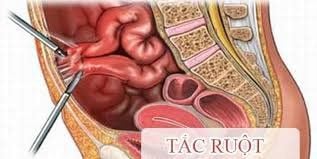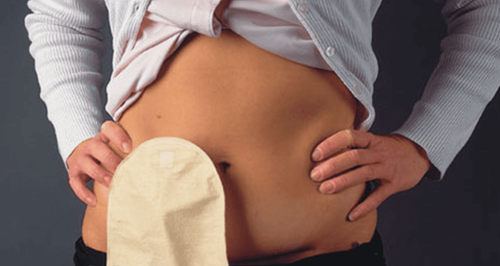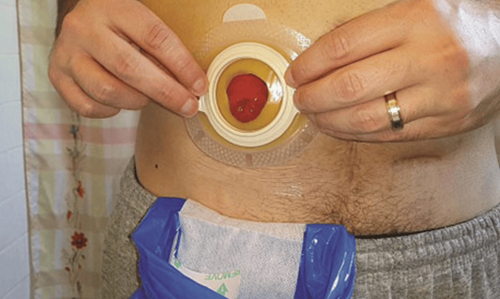This is an automatically translated article.
Laparoscopic colostomy is performed to create an opening of the ileum or colon outside the abdominal wall, stool will move from the intestinal lumen through this opening to exit, instead of through the real anus . The colostomy can be used permanently or temporarily.
1. Laparoscopic surgery to create artificial anus in which case?
An ostomy is an opening outside the abdominal wall of the colon or ileum, stool and gas will exit the body through this opening without going through the real anus. Waste will be collected through a bag attached to the body.
Artificial anus includes two types: temporary colostomy and permanent colostomy. The temporary colostomy is the type that is used for a short time, about a few months to facilitate the pathological lesions below to rest. As the lesions heal, the surgeon closes the stoma and re-establishes circulation through the real anus. Permanent colostomy is often performed in patients with colon and rectal cancer, who will use this anus for the rest of their lives.
There are two methods of surgery to create an colostomy, which are open surgery and laparoscopic surgery. When performing open surgery, the doctor will make a large incision in the abdominal wall, patients often have prolonged postoperative pain and are at risk of many complications. Compared with open surgery, laparoscopic colostomy is less invasive, less complicated, less painful, and faster to recover. Due to many advantages, laparoscopic colostomy is more and more commonly performed.
Laparoscopic colostomy is indicated in some cases such as:
Colon cancer in the late stage, no longer able to be removed. Severe ulcerative proctitis, bleeding Colon diverticulum disease, rectovaginal fistula or rectal fistula Trauma, complex anal fistula through the sphincter, making an ostomy to protect the anastomosis, ..

Bệnh nhân viêm loét trực tràng cần được mổ nội soi
2. How is endoscopic colostomy performed? 2.1. Preparing for surgery
2.1. Preparing for surgery
The patient is consulted by the medical staff about his current health status, the purpose of the operation, the risk of complications that may be encountered after surgery. Before surgery, the patient will be tested to assess cardiovascular function, respiratory function, degree of intestinal obstruction. Patients need to fast for 6 hours before surgery.
2.2. Laparoscopic surgery steps to create an artificial anus
The patient lies supine on the operating table, arms closed. The surgical team performed endotracheal anesthesia. The surgeon places the trocar 10mm below the navel, then inflates CO2 into the abdomen with a pressure of 12mmHg. Through the image obtained on the screen, the doctor will assess the status of the abdomen, the location of the lesions, from which to choose the appropriate bowel position to bring out the abdominal wall to make an stoma. After determining the appropriate bowel segment, the doctor will use clamps on the intestine to fix it. The doctor removes a circular part of the skin outside the abdominal wall, about 2.5cm in diameter, and makes a longitudinal incision to the fascia. After separating the muscle fibers to the two sides, the outer fascia will be cut and the posterior fascia is made. Upon reaching the parietal peritoneum, the abdominal wall is carefully shallowed with fingers to create a tunnel. Surgeons use Babcock to remove the colon from the abdominal wall. The terminal end of the colon will be brought out about 2cm outside the abdominal wall, then using sutures to fix the colon to the abdominal wall fascia with four stitches at the four corners. Continue suturing again with loose stitches so that the colon protrudes 0.5-1cm from the abdominal wall. The technique of making an ileostomy is done in the same way as above.

Phần lớn người bệnh thường diễn biến thuận lợi, lưu thông ruột và ăn uống tốt
2.3. Handling possible complications after laparoscopic colostomy
Some complications that patients may encounter after laparoscopic surgery such as:
Intestinal obstruction: There are many possible causes of intestinal obstruction after surgery such as the tunnel on the abdominal wall is too narrow, the stoma is twisted or the colostomy is twisted. was brought out upside down, and lesions in the colon above the artificial anus, ... The patient will usually be operated on again to handle. Perianal dermatitis: This is a common condition in the ileum artificial anus. The patient will be instructed to take care of the skin by washing soap, applying ointment, and applying antibiotics if necessary. Stick the bag on the outside of the abdomen to limit the fluid flowing around. Abscess around the artificial anus: A part of the colostomy mouth will be cut, separated from the skin edge to drain pus, clean, and change the dressing daily. Necrosis of the colostomy: If the stoma is suspected to be twisted or the necrosis has spread beyond the abdominal wall, the patient will be re-operated for handling. The artificial anus is retracted into the peritoneal cavity; colostomy prolapse: the patient will be re-operated, re-doing the stoma.

Bệnh nhân có thể bị tắc ruột sau phẫu thuật
3. Caring for patients after laparoscopic surgery to create an artificial anus
In the first 24 hours after surgery, the patient will be closely monitored for the whole body condition, pulse, body temperature, blood pressure, breathing rate,... The doctor will prescribe pain relievers, fluids, antibiotics. birth to fight infection,... The patient will be given a light meal of porridge and milk after having a bowel movement.
Most of the patients usually have a favorable condition, have good bowel movements and eat well. The colostomy usually produces stool about 2-3 days after surgery. Initially gas and mucus mixed with a small amount of blood, then loose stools and then solid stools. The colostomy is usually light red or pink in color and is painless to the touch. The colostomy may be swollen for the first 3 to 5 days after it is created. Patients are usually discharged from the hospital about a week after surgery. The skin around the colostomy hole should be cleaned daily to avoid infection. The ostomy bag needs to be cleaned several times per day.
The colostomy has no valves or muscles, so the patient cannot control the passage of stool. People who wear ostomy are often worried and self-deprecating because the bad smell from the colostomy can alienate people around. However, some new generation ostomy bags have deodorant filters and air vents that can solve this problem.
After laparoscopic colostomy, the patient can continue to perform activities such as daily life, can go to work, go to school, do housework, play sports... treatment will not hurt the disease or affect the colostomy.
Vinmec International General Hospital with a system of modern facilities, medical equipment and a team of experts and doctors with many years of experience in neurological examination and treatment, patients can completely peace of mind for examination and treatment at the Hospital.
To register for examination and treatment at Vinmec International General Hospital, you can contact Vinmec Health System nationwide, or register online HERE.
SEE MORE
Common complications and how to take care of an ostomy What are the types of colostrum commonly used How to treat anal fistula?













